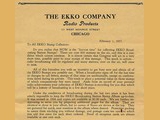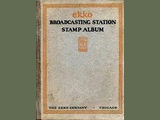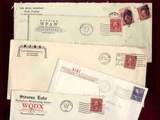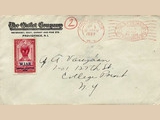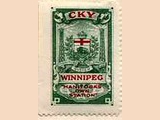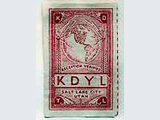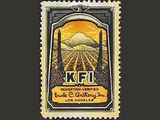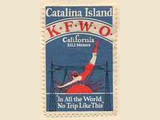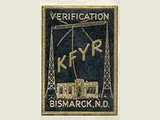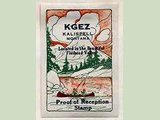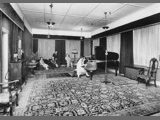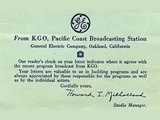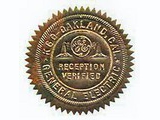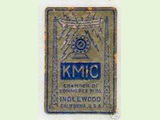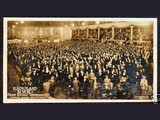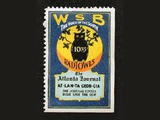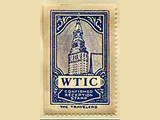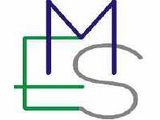Die Geschichte der QSL-Marken von EKKO und BRYANT
Seite in Bearbeitung
"The new radio stamp fad"
©Copyright 2006 C. M. Zelbst. Mit freundlicher Genehmigung des Autors

![]() Unsubstantiated rumor has it that the American Bank Note Company quickly redesigned a stamp that had been submitted to, and rejected by, the United Stated Postal Services and that the EKKO Company accepted the design but insisted on the use of numerous colors for their customers. The stamps, framing the American Bald Eagle with two radio towers in the background and a station bar where the broadcast station call letters could be imprinted, measured in frame height 35mm and in frame width 22mm. With perforation (12) and plate cuts, the finished stamps measured approximately 40mm in height and 25mm in width, familiar dimensions to American postage stamp collectors.
Unsubstantiated rumor has it that the American Bank Note Company quickly redesigned a stamp that had been submitted to, and rejected by, the United Stated Postal Services and that the EKKO Company accepted the design but insisted on the use of numerous colors for their customers. The stamps, framing the American Bald Eagle with two radio towers in the background and a station bar where the broadcast station call letters could be imprinted, measured in frame height 35mm and in frame width 22mm. With perforation (12) and plate cuts, the finished stamps measured approximately 40mm in height and 25mm in width, familiar dimensions to American postage stamp collectors.
These stamps, often referred to as "Cinderella's" by todays collectors, would be purchased by the radio stations from the EKKO Company and then, when their respective listeners provided written information identifying the details and proving that they had indeed tuned in and listened to a particular broadcast, the station would send the listener a VERIFIED RECEPTION STAMP (VRS) with the station's call letters.
The listener was suppose to provide the date and time they had listened to the broadcast as well as details as to what they had heard, and then send the information along with 10 cents to the radio station. The radio station would check it's broadcast log and confirm, or verify that the information was correct, and if so, then in return send the listener a VRS stamp.
What came as a complete surprise to the EKKO Company was that collecting these stamps became almost as great of a sensation as listening to the radio broadcasts, and the demand for Verified Reception Stamps increased dramatically as this new hobby swept the nation! In an effort to legitimize the hobby, and as an additional means of gaining revenue by selling advertisement space, the EKKO Company published a hardback stamp album in 1924, and several different paperback versions beginning in 1926 and continuing into 1927. A bit of trivia is that the albums did not list the stations in alphabetical order within the respective state or country sections, but were instead arranged to provide color contrast!
The 1926 - 1927albums were produced for at least 18 stations, each of which purchased these paperback albums with their station call letters on the cover. To their initial surprise many found that "their" special edition albums were filled with advertisements sold by the EKKO company to radio manufacturers and the like! As with the 1924 hardback album, the paperback editions boldly proclaimed that the albums "contained spaces for stamps from every broadcasting station in the United States and Canada", which wasn't really true. Both the hardback and paperback album had printed call signs for stations that had purchased EKKO stamps, and blank boxes for stations that had not! More importantly, and perhaps a bit vindictively on the part of the EKKO Company, stations that had previously participated in the program but then "fell out" and started producing their own verified reception stamps were not listed in subsequent albums!
The 18 known stations that participated in the paperback album program are:
KDKA - Pittsburgh, PA KHQ - Spokane, WA KSBA - Shreveport, LA KYW - Chicago, IL WBAW - Nashville, TN WBZ - Springfield, MA
WCAO - Baltimore, MD WEEI - Philadelphia, PA WFBL - Syracuse, NY WGHP - Detroit, MI WGR - Buffalo, NY WHEC - Rochester, NY
WJAY - Cleveland, OH WMAQ - Chicago, IL WOW - Omaha, NE WRNY - NYC, NY WTMJ - Milwaukee, WI WCAU - Philadelphia, PA
To further keep this new hobby growing, the EKKO Company recognized that they would have to provide collectors a means to complete their collections, something that was impossible to do under the "rules" since most broadcast stations were not powerful enough to send out signals that would reach the entire country, which meant that collectors would not be able to comply with the written detail requirement in order to get the stamps from the broadcast stations directly. To the dismay of their customers, the broadcast stations, in 1925 the EKKO Company began selling the stamps directly to the public.
When the EKKO Company published their hardback album in 1924, they were selling stamps to 592 stations in the United States and Canada, and at the height of the collecting craze they were selling their stamps simultaneously to slightly more than 650 broadcast stations located throughout North America and the Caribbean!
It is commonly accepted that this is the maximum number of stations, however, our research has identified over 844 stations that participated in the program between 1921 and 1929, and the list continues to grow! These stations were located in the United States, Canada, Cuba and Mexico.
_thumb.jpg)
![]() Of course, success breeds imitation, and there were a number of companies that attempted to compete with the EKKO Company in offering stamps to broadcast stations, which added to the variety and scope of collectibles, but which may have ultimately hastened the demise in popularity of the hobby. In addition, several radio stations decided to design and offer their own version of these stamps, with many being so unique and rare today as to be very valuable. Not surprisingly, being that stamp collecting was after all the hobby of kings, none of the major suppliers issued a comprehensive album, and so collectors tended to simply paste these non-EKKO examples into their EKKO Albums.
Of course, success breeds imitation, and there were a number of companies that attempted to compete with the EKKO Company in offering stamps to broadcast stations, which added to the variety and scope of collectibles, but which may have ultimately hastened the demise in popularity of the hobby. In addition, several radio stations decided to design and offer their own version of these stamps, with many being so unique and rare today as to be very valuable. Not surprisingly, being that stamp collecting was after all the hobby of kings, none of the major suppliers issued a comprehensive album, and so collectors tended to simply paste these non-EKKO examples into their EKKO Albums.
As these stamps became more and more popular, the EKKO Company expanded it's market with the issue of a second EKKO design, this one with a beaver instead of an eagle, which was for the Canadian broadcasters to use with their listeners. The EKKO Company also sold stamps to broadcasters in Mexico and the Caribbean, but used the American Eagle design. These stations, because there are so few, are extremely rare in todays marketplace!
In the original printing sequences employed by the American Bank Note Company, the first sequence was the body of the stamp which included the Eagle or Beaver but did not include the station call sign letters or the words "verified reception stamp". This allowed the printing in large enough quantities to make the stamps affordable while still allowing for customization of the call letters of a particular radio station.
 For only $1.75, the Ekko Company offered an album to the collector of new stamps. The album contains pages preprinted with an outline of each of the stamps currently available, a listing of broadcast station call letters and wavelengths, and a nice map on the inside cover showing the locations of these stations. Spaces were also left for stations not yet participating, or stations that were just coming on the air. In addition, there was space to jot down up to four dial settings at your own time of reception.
For only $1.75, the Ekko Company offered an album to the collector of new stamps. The album contains pages preprinted with an outline of each of the stamps currently available, a listing of broadcast station call letters and wavelengths, and a nice map on the inside cover showing the locations of these stations. Spaces were also left for stations not yet participating, or stations that were just coming on the air. In addition, there was space to jot down up to four dial settings at your own time of reception.
"Proof of Reception" cards were furnished with the album. Listeners needed only to send a few facts on these cards about when and where on the dial they had heard a broadcast, plus ten cents to cover mailing costs, to the station. There the card was checked against the station log for accuracy, and the listener was mailed a stamp with the station's call letters and design upon it.
BRYANT-Stamps
Sortierreihenfolge: Rufzeichen
Bryant war eine von mehreren Firmen, die versuchte, aus dem neuen Boom Geschäft zu schlagen. Angeboten wurden vereinzelt auch Marken für Stationen außerhalb der USA und Kanadas. Die Rufzeichen wurden stets eingedruckt, das Design blieb unverändert: Die Weltkugel zwischen zwei Antennenmasten.
Manche Stationen gingen eigene Wege
Nicht alle Stationen ließen sich vereinnahmen - vom Zuspruch der Hörer wollten sie dennoch profitieren.
QSL-Stamp-QSL
Adventist World Radio
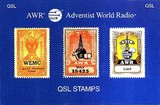
![]() Im November 2000 bestätigte AWR (Adventist World Radio) Empfangsberichte mit einer QSL-Karte, die drei Aufkleber zeigte:
Im November 2000 bestätigte AWR (Adventist World Radio) Empfangsberichte mit einer QSL-Karte, die drei Aufkleber zeigte:
- Den "Verification Stamp" von WEMC, den ersten Sender der Adventisten, im College von Berrien Springs, Mich - der heutigen Andrews University
- den Aufkleber, mit dem AWR 1977 Berichte für AWR Ekkala, Sri Lanka, bestätigte,
- den Aufkleber, mit dem AWR 1996 Berichte für KSDA, Guam, bestätigte.
Gedenkmünze
2016: 25 Jahre öffentlich-rechtlicher Rundfunk in Andorra
![]() Am 01. Juni 2017 wurde eine Spezialmünze mit einer Auflage von
Am 01. Juni 2017 wurde eine Spezialmünze mit einer Auflage von
85.000 Umlaufmünzen ausgegeben. Mit der Gedenkmünze wird das 25-jährige Jubiläum der öffentlich-rechtlichen Rundfunkanstalt Andorras und damit der Beginn der Ausstrahlung des andorranischen öffentlichen Radios und Fernsehens begangen. Das Münzmotiv zeigt ein Mikrofon und eine Antenne, sowie den Schriftzug „25è ANIVERSARI DE RÀDIO I TELEVISIÓ D’ANDORRA“, das Ausgabejahr „2016“ und den Ausgabestaat „ANDORRA“.
Quelle: ![]() ext. Link [05.07.2018]
ext. Link [05.07.2018]
